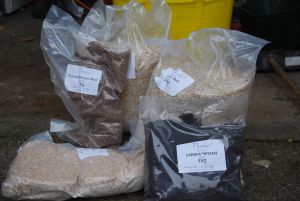It’s a bit of a techie update this, and to be honest I got bored writing the first draft, so heaven only knows how you’ll get on with this slightly (I think) improved version. I did think there might be someone, somewhere, out there who has followed the brewing of Saison a Trois and is interested in details of the fermentation, but to be honest I couldn’t find any way to make it even remotely exciting! You take your own chances…
Before embarking on this project there was a fair bit of research done into what yeast to use and how to handle its particular quirks, and with various (mostly internet) sources of information not necessarily all entirely agreeing, here’s our experience to add to the mix. We chose Whitelabs WLP565 Saison I. It is widely suggested that this yeast is one of the several strains that together form the house yeast used for Saison Dupont so it seemed a good basis for our own effort – of course it could be that it was only actually suggested once and then widely replicated around the internet, but I haven’t seen anything saying it isn’t true so I’m prepared to go with it. From this choice two themes emerged from the information available – firstly lots of reports of stuck fermentations and failure to attenuate out to the expected level; and secondly a suggestion that the yeast likes temperatures somewhat higher than the typical ale yeast range. Perhaps even as high as 32°C. So we resolved to go for a warm ferment and see what that resulted in.
Before we go on perhaps I should explain more about how my temperature control for fermentation is set up. It all takes place in a large insulated cupboard into which a fermenter (aka a big blue barrel) is placed. In the cupboard is a heater controlled by a PID that switches the heat on whenever the temperature (according to a sensor within the cupboard) falls below a set temperature and off when it rises above the target. Actually there’s a 1 degree buffer either side of the set temperature so that the heater isn’t constantly switching on or off, but you get the idea. So the fermenting beer sits in an environment at or about the desired temperature, and raising the cupboard temperature will allow* the beer temperature to rise too.
* I’ve found this volume of actively-fermenting beer will naturally rise about 2 degrees above the surrounding air temperature in this set-up due to the heat generated by the process itself.
Cooling is a slightly different arrangement – the FV is wrapped in several loops of beer line connected to a reservoir and pump. When the temperature of the beer (this time monitored by a probe in the FV itself) exceeds the target set on a second PID the pump is switched on. This then circulates water from the reservoir, through a beer line chiller unit and round the FV. This direct cooling is quite effective and can be used to drop the beer down to just a couple of degrees after fermentation is over.
Back to the saison then. At first the temperature limit was set to 24°C and after 24 hours the fermentation was going strong. On day 2 the temperature settings were stepped up to 26°C with gravity already down to 50% attenuation by this stage. On day 3 it was time for another step up to 28°C, and the gravity had further dropped with plenty of signs of continuing activity. I was then away for work overnight but once back on day 5 things were clearly slowing down and we were close to the expected final gravity*. Despite setting temperatures up to 32°C by this stage the cold weather was limiting the heating capacity of the cupboard and the slowing fermentation was no longer producing as much heat itself so we peaked at about 28.5°C.
* actually it appeared to go some way below the expected gravity, but a later check for equipment calibration showed that slightly inaccurate readings were being obtained and adjusting for this the gravity was exactly in the right place at about 90% attenuation.
After another day at that level the temperature was dropped right down ready for transfer to a secondary vessel and on day 8 it was transferred across. This is the point at which fruit was added. 2kg of frozen blackberries were heated to pasteurize them and once cooled enough they were added to the secondary FV and the beer added on top of them.
As I write this that FV is sitting in the cupboard at about 16°C, and the remaining yeast is clearly enjoying the small amount of sugar the fruit has provided. Estimates are that no more than one point of gravity has been added by the fruit, so it won’t significantly change the ABV, but the effect on colour is much more significant, and hopefully will add some great flavour too. We’ll find out in a few days when it is racked off to the wooden cask for ageing.









